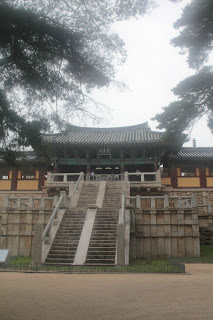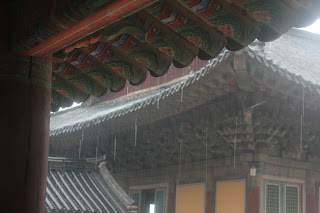This one is really old...not sure how I lost it in the drafts of my email...
__________________________
I've decided Korean is harder to learn than Chinese. This, despite Korean having a very logical alphabet, and my having not-insignificant motivation to learn it.
A contributing factor to my struggle, I'm sure, is that I learned Chinese in an academic setting, while academia was my job. It's harder, I discovered, when you're working full time. Saturday Korean school led to my hiring a tutor, but I only had a couple of months before I moved and started a new job. I found another tutor, this one a college student who met me at Borders for an hour a week. Then on deployment, a fellow officer and native Korean speaker, gave me informal lessons. I'm grateful for their help, but still feel I don't have a very useful grasp of the language.
When I started learning Chinese, I understood it to be one of the most difficult languages for native-English speakers to learn. Chinese characters, for one, are notoriously difficult. The shape of the character does not often give hints as to its pronounciation or meaning (although there are just enough exceptions to make studying characters a bit like a puzzle)--you must know not only the final shape of the character, but the stroke order, pronounciation, tone, and meaning. Which brings up the second most difficult aspect of Chinese--it's tonal. MA prounced with a high flat tone, or mA pronounced with a medium rising tone, or ma prounced with a medium dipping tone, or Ma prounced with a firm dropping tone all have different meanings. And of course, there are just those sounds that are prevalent in Chinese but all but absent from English--"x" vs. "ch" vs. "sh"; "j" vs. "zh", and so on. However. Once you've figured out how the tones worked and gotten the hang of the rhythm of normal conversation, tones cease to be a major barrier to language-learning progress. And although there's not much in the way of shortcuts to learning characters, you can be a functional literate as long as you can recognize the character.
The easiest feature of Chinese for a language-learner is its grammar. Or lack of grammar. Not that the lack is complete--there are a few rules about order and a few patterns to remember (I had a teacher in Beijing who, with a lisp, frequently harped on the "rethultative compliment"). But Chinese does not conjugate. To change tenses, you add a word here or there, or craft your sentence in such a way that time is understood. There is almost no change based on honorifics--you'd use the same grammar when speaking to your grandmother as you would to the neighborhood kids. The sentence, "I eat noodles", is just three words in Chinese--I, eat, and noodle (the fact that you're probably eating more than one is understood). In Korean, this same sentence sounds like this: "I (+ subject particle) noodle (+ object particle) eat (<--conjugated with one of three or so levels of politeness). Oh, and you might use a different subject particle and a different verb if you were talking about your grandmother eating noodles.
The grammar rules, in my experience, make it much harder to be able to use new vocabulary. I can't just learn the verb for "go"--I have to learn present, future, and past tenses, as well as three levels of politeness. "Kada" becomes "kamnida", kasumnida", "kargo-ayo", "kasoyo" or "kayo", or probably three or four others that I haven't learned or have forgotten, depending on the situation.
China's Communist Party is not exactly a lovable organization, but I will say I am grateful to them for creating "pinyin"--a standardized system of romanization for Mandarin Chinese. The rules are simple (even if they don't follow English pronounciation exactly) and consistently applied. There are a couple of methods of romanizing Korean, but as far as I've been able to tell, none of them are applied consistently. Take for example, the next in line for the North Korean dictatorship: 김정은. I've seen the name romanized most often as Kim Jong-eun, Kim Jong-un, or Kim Jung-eun, but the "official" romanizations are Kim Chŏng'ŭn and Gim Jeong-eun.
It may just be that I've been studying Chinese longer (almot a decade!), or that pinyin makes Chinese pronounciation more accessible, but there are certain sounds in Korean that I find difficult to hear, and thus, to reproduce. I remember one of my first Korean lessons--my handsome then-boyfriend was explaining the difference between "g" "k" and "kk". "No, it's not 'kong', it's 'kong'." I still get this confused--it's one of the reasons I have given up hope of ever being able to spell decently in Korean. Also difficult are the dipthong vowels. My tutor here tried to explain it to me--"It's like 'uh' and 'ee' put together. 'Whay'. See?"
I was excited when we got orders to Korea--my experience with Chinese was that I learned much faster when I was actually in China, both because I had the motivation to learn to feed myself and otherwise get by, and also because I had almost constant reinforcement of the new vocabulary I learned. What I wasn't taking into account was that in Korea, I'd be living in an expat palace, working in Mini-America, and mostly interacting with Korean people who speak much better English than I do Korean. In most instances, it's less work for them to just speak English than it would be to have me not or mis- understand their Korean. I am simultaneously frustrated and grateful--the former because I'm irritated by Americans who think it's their birthright to be spoken to in English anywhere in the world, the latter because the chances of my mis- or not understanding their Korean is depressingly high.
I am making progress, though, and I guess baby steps are better than no steps. I'm finding I can understand more than when we first got here in July, and I've learned a few high-frequency phrases that I can throw around quite fluently ("I'm sorry, my Korean is really bad" and "My last name is Kim because my husband is Korean").
Sunday, September 23, 2012
Friday, September 21, 2012
Gyeongju
Found this one when I uploaded the Taiwan post...it's old--we went to Gyeongju in July.
We rented bikes to sight-see around the city.
Gyeongju was the capitol of the Silla Dynasty in the 7-9th centuries, and is known for the "tumuli", or burial mounds that are all over the city and the surrounding area.
Really, they're everywhere.
I really liked this lily garden.
Frogs!
Cheomseongdae, a famous observatory
This little guy, a roof-end tile, is a famous artifact housed in the local museum.
We had great weather for our day of biking, then the next day braved the drizzle and trekked up to one of Korea's most famous temples, Bulguksa.
A little farther out was another famous Buddhist site, Seokguram Grotto.
It's famous for it's domed ceiling (covered by grass, behind the building in the picture) and large stone Buddha.
I'm glad we were able to see so much of Korea while I was there.
Thursday, September 20, 2012
Taiwan
I'm back in California, and I may or may not get around to writing a "goodbye Korea" post, but I did want to share some of our pictures from our Taiwan trip over Labor Day. (Be forewarned--most of what we did was eat, so there are a lot of food pics.) We spent two nights in Taipei, then went south about an hour for a day of luxury at a hot-springs resort.
Asparagus juice at the airport
Awesome little egg tarts from a street stall
Taipei. We were pretty lucky with the weather; it was warm, but not too steamy.
At the flower market, attached to the stadium-sized jade market. Have I mentioned I have a wonderful, long-suffering husband?
Chiang Kai Shek Memorial area
The memorial
HUGE watermelon, at a stall where we bought some delicious fresh watermelon and pineapple juice.
Night market 1, near our hotel. Kind of seemed like a local hang-out.
Did I mention we ate a lot on this trip?
Breakfast, day 2
We spent part of the morning exploring a local temple, which was really busy with Buddhists and not just tourists.
Afternoon was the National Palace Museum. When the Nationalists fled China after the Communists defeated them in the civil war, Chiang Kai Shek and crew took as much of China's treasure as they could carry. Consequently this museum has some of the best art and archaeological treasures anywhere in Asia.
Street market 2, at Shihlin. This has to be one of the best traditions in Asia...
The food court. Pretty upscale with the escalator, but I image the people working the food stalls have been doing their thing the same way since long before there were escalators.
Finally worked up the nerve to try stinky tofu! Tastes better than it smells, thankfully.
Boba tea, a local specialty that's been exported all over Asia.
Breakfast, day 3. We were still pretty full from the night market the night before, but had to try another local specialty--fresh soy milk, dumplings, and rice-wrapped crispy bbq.
After breakfast we took the subway and a bus down to Wulai, an area famous for aboriginal culture, hot springs, and resorts
Oh, and a waterfall.
The hotel was pretty swanky.
Our digs
The hot-spring-fed outdoor pool, with a corner of the third-floor restaurant in view in the top left.
Afternoon welcome tea. Yep, still eating.
Tea was delicious, but not filling enough, so we went next door to sample some of the Wulai specialties:
Wild boar, noodles, and mountain veggies.
We spent the afternoon swimming, lounging, and getting a delightfully indulgent massage. When we got back to the room that night after a delicious French dinner, there was a rose and a "pillow menu" on the bed...
which concerned me for just a second, but it really was a menu of pillows. Told you the digs were swanky.
The next day it was back to the airport. Upon checking in, we were informed that we were booked on the Hello Kitty flight. What?? This is the check-in counter.
Gate.
We skipped the mini-size pink chairs and oped for the orchid garden farther down in the terminal. Beautiful, no?
It was a pleasant journey, in fact.
Subscribe to:
Comments (Atom)



























































